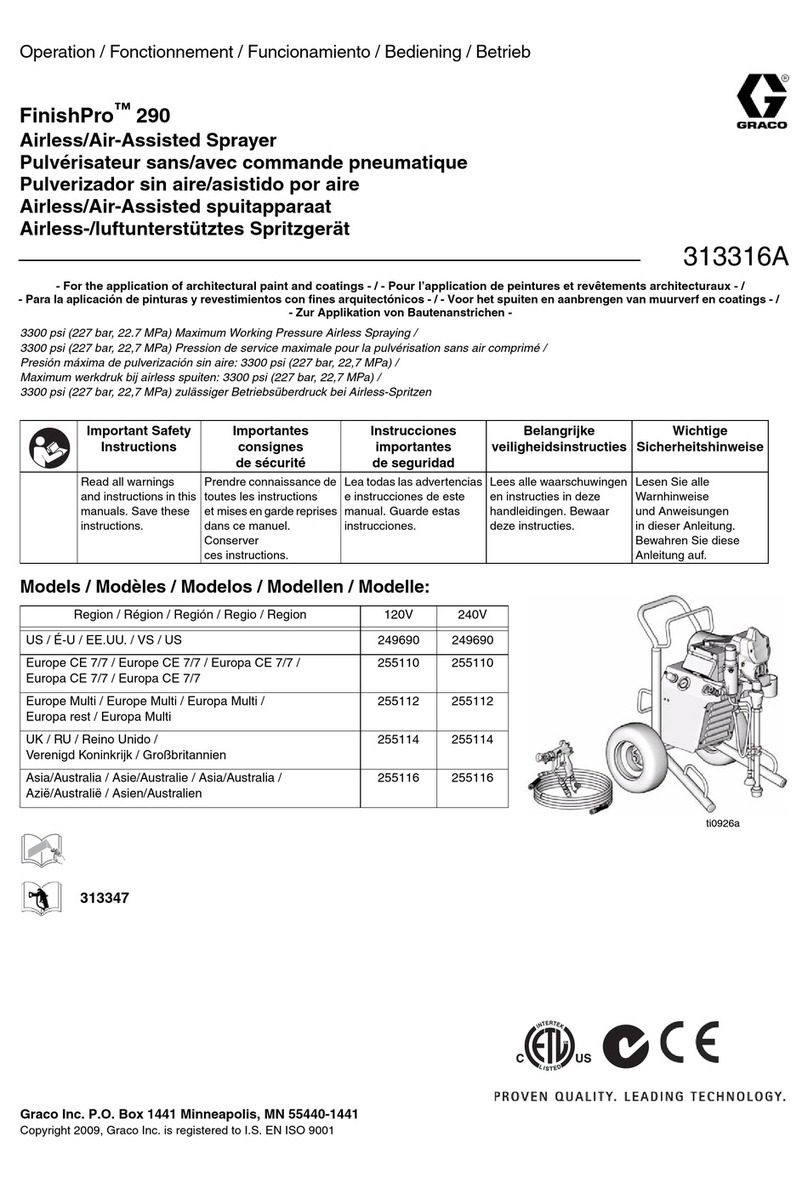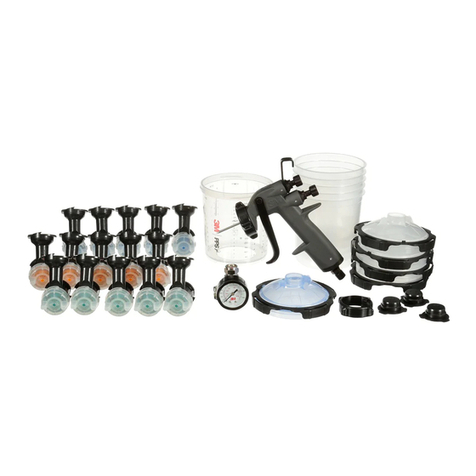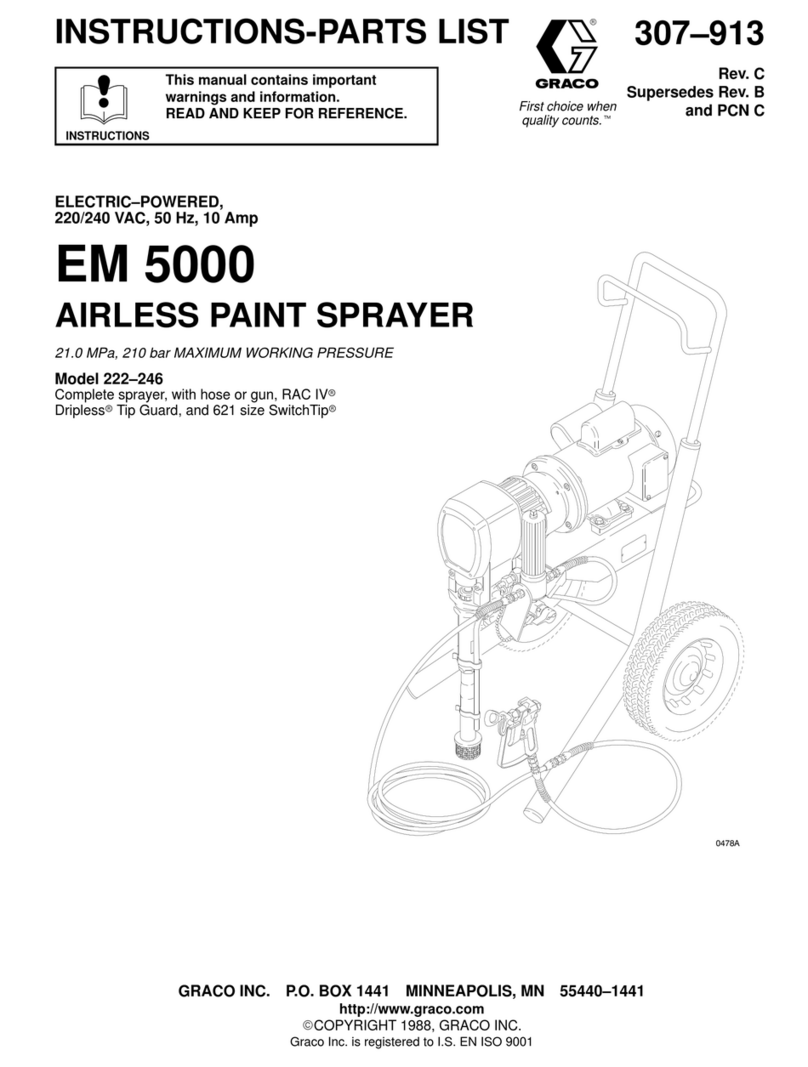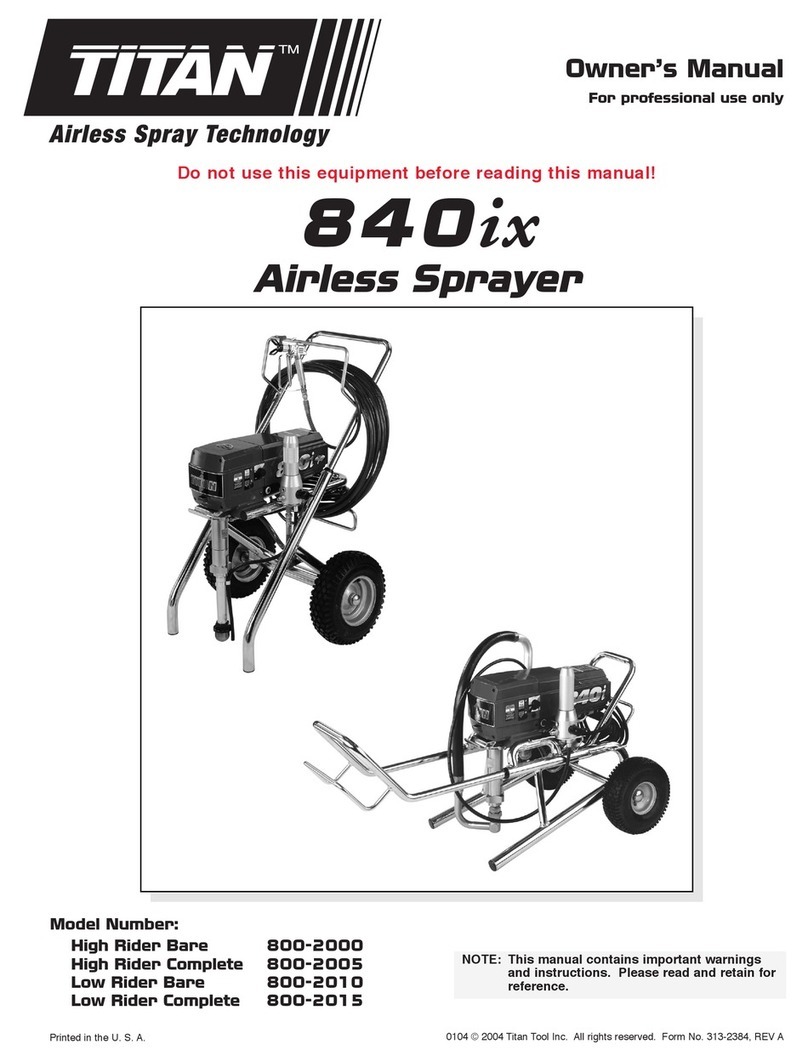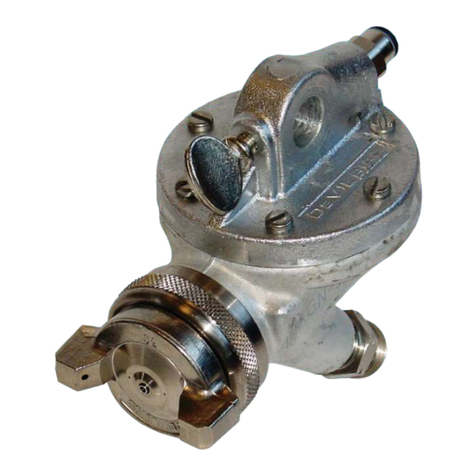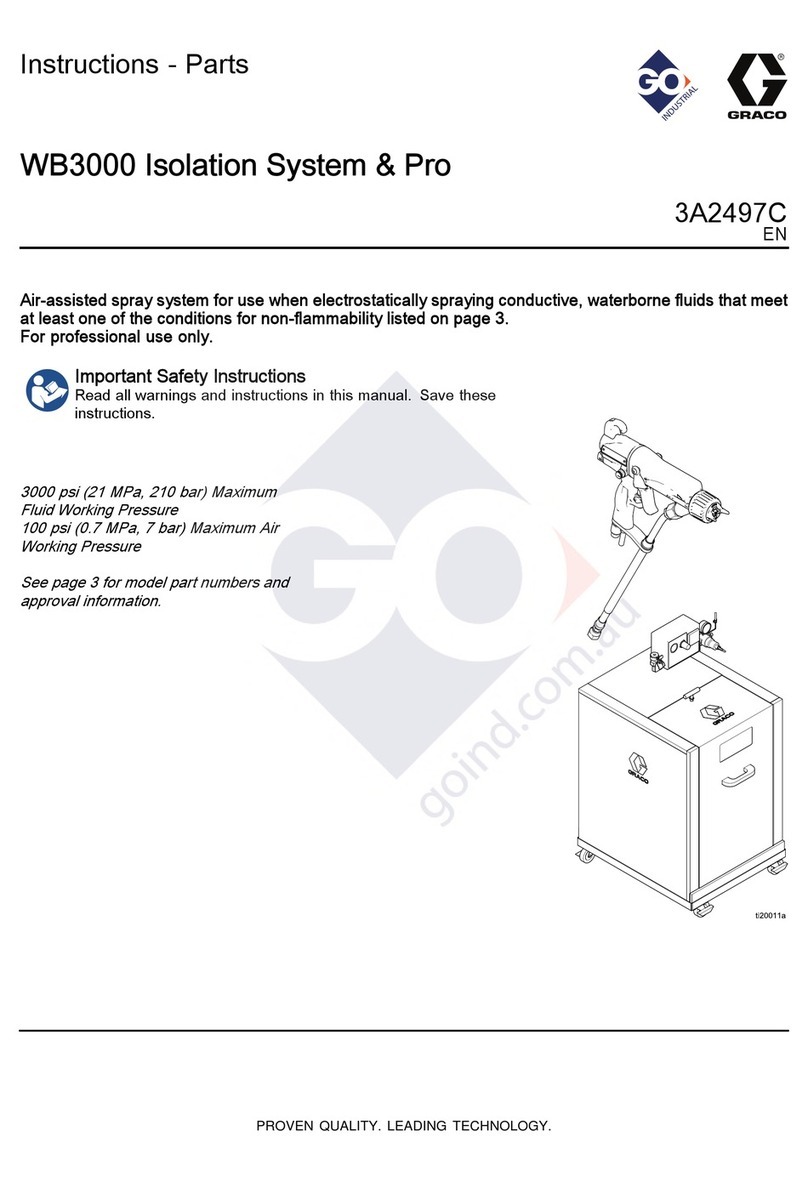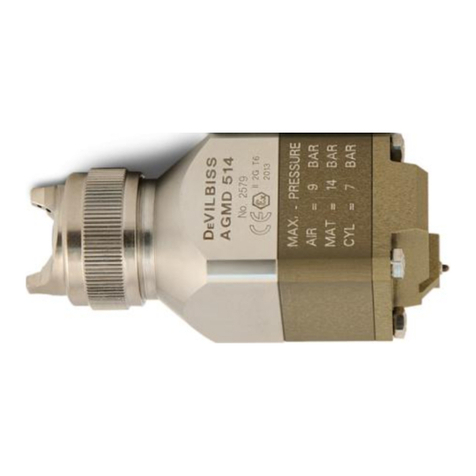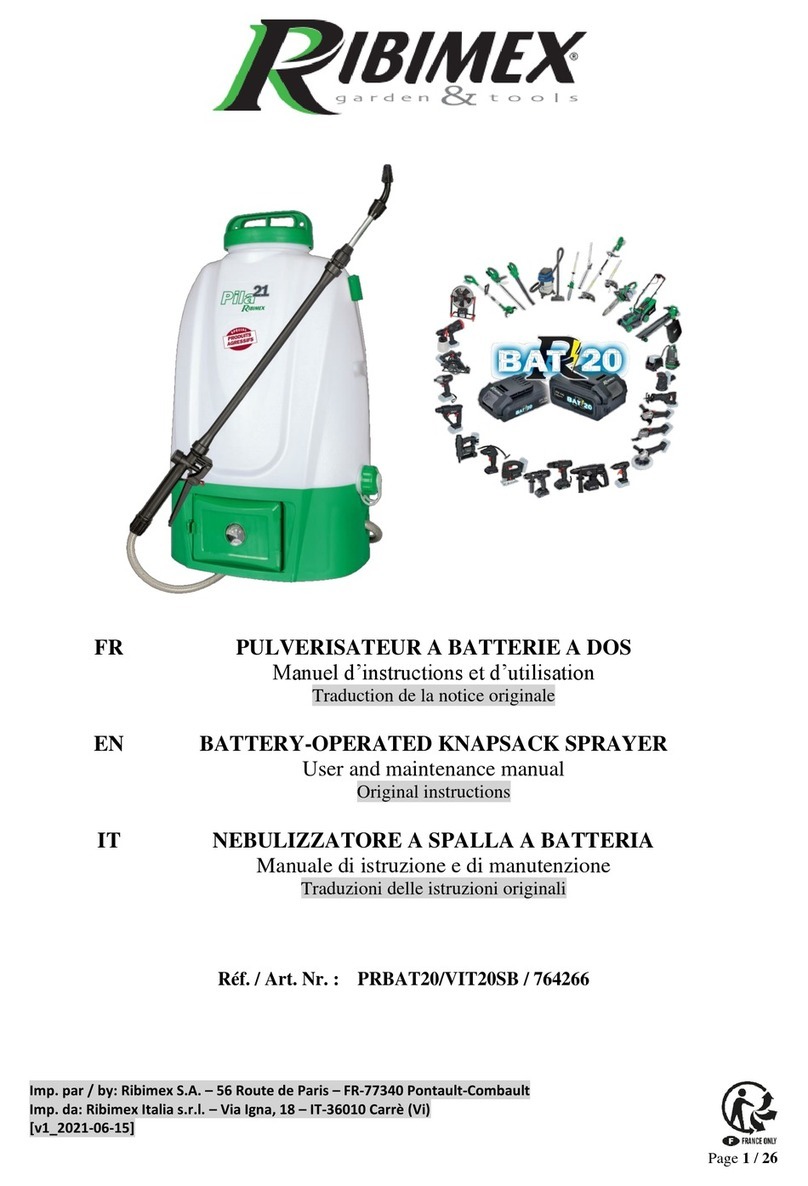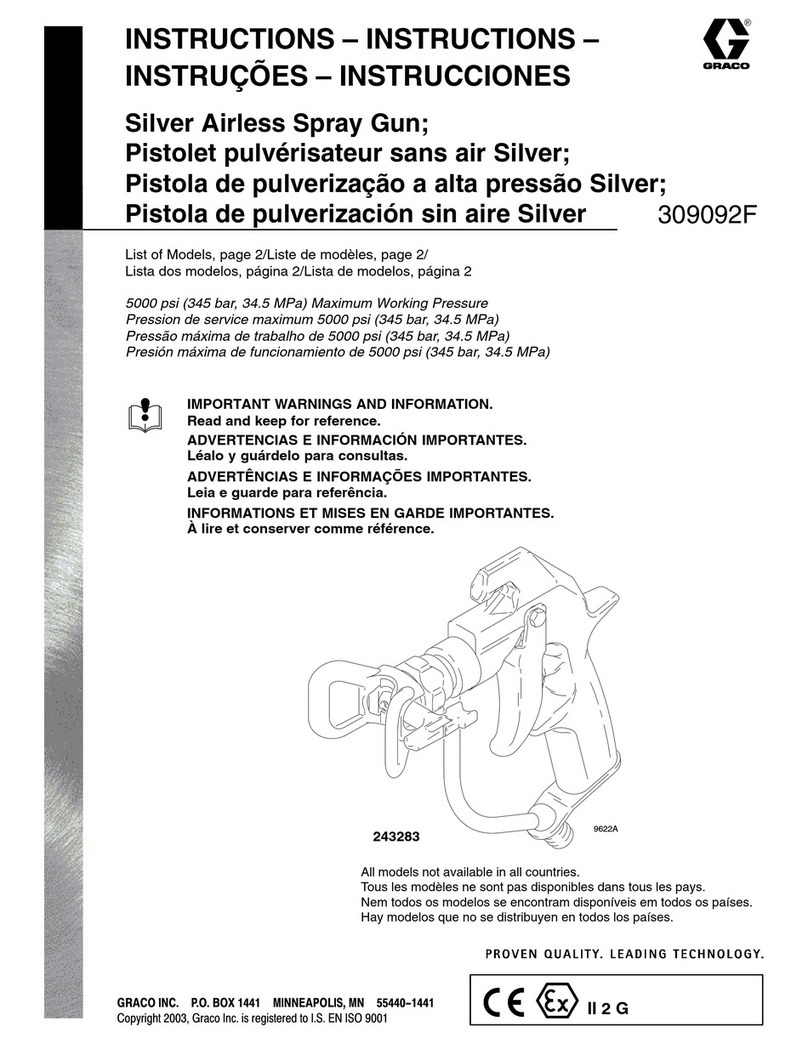FAST AG Solutions Fast Sprayers 9500 Series User manual

HIGH-CLEARANCE
CENTER PIVOT
SUSPENDED BOOM
FIELD SPRAYER
9500 & 9600
SERIES
OPERATOR'S MANUAL
960 9500 & 9600 SPRAYER 4-19-2019

LIMITED WARRANTY
FAST AG Solutions warrants to the buyer that the new machinery is free from defects in
material and workmanship.
This warranty is only effective as to any new machinery which has not been altered,
changed, repaired or treated since its delivery to the buyer, other than by FAST AG
Solutions or its authorized dealers or employees, and does not apply to accessories,
attachments, tools or parts, sold or operated with the new machinery, if they have not been
manufactured by FAST AG Solutions.
FAST AG Solutions shall only be liable for defects in the materials or workmanship
attributable to faulty material or bad workmanship that can be proved by the buyer, and
specifically excludes liability for repairs arising as a result of normal wear and tear of the
new machinery or in any other manner whatsoever, and without limiting the generality
of the foregoing, excludes application or installation of parts not completed in
accordance with FAST AG Solutions operator's manual, specifications, or printed
instructions.
Written notice shall be given by registered mail, to Fast Distributing within seven (7) days
after the defect shall have become apparent or the repairs shall have become necessary,
addressed as follows: FAST AG Solutions 4130 Commerce Boulevard, Windom, MN
56101.
This warranty shall expire two (2) years after the date of delivery of the new machinery.
If these conditions are fulfilled, Fast shall at its own cost and at its own option either repair
or replace any defective parts provided that the buyer shall be responsible for all expenses
incurred as a result of repairs, labor, parts, transportation or any other work, unless Fast
has authorized such expenses in advance.
The warranty shall not extend to any repairs, changes, alterations, or replacements made
to the new equipment other than by Fast or its authorized dealers or employees.
This warranty extends only to the original owner of the new equipment.
Rubber parts are not warranted. (including tires, hoses, grommets)
This warranty is limited to the terms stated herein and is in lieu of any other warranties
whether express or implied, and without limiting the generality of the foregoing, excluded
all warranties, express or implied or conditions whether statutory or otherwise as to quality
and fitness for any purpose of the new equipment. Fast disclaims all liability for incidental
or consequential damages.
This sprayer is subject to design changes and FAST AG Solutions shall not be required
to retro-fit or exchange items on previously sold units except at its own option.
Fast Distributing Inc.

SERIAL NUMBER LOCATION
Always give your dealer the serial number of your Fast Distributing Center Pivot High-Clearance Sus-
pended Boom Field Sprayer when ordering parts or requesting service or other information.
The serial number is stamped on a serial tag attached to the trailer frame by the ladder where indicated.
Please mark the number in the space provided for easy reference.
Model Number 9_ _ _
Sprayer Serial Number 9_ _ _ _ _ _ _ _ _ _

TABLE OF CONTENTS
SECTION DESCRIPTION
PAGE
1 Introduction ............................................................. 1
2 Safety ................................................................... 2
2.1 General Safety ...................................................... 3
2.2 Operating Safety ................................................... 4
2.3 Chemical Safety ................................................... 5
2.4 Maintenance Safety .............................................. 6
2.5 Hydraulic Safety ................................................... 6
2.6 Transport Safety ................................................... 7
2.7 Tire Safety ............................................................ 7
2.8 Storage Safety ...................................................... 7
2.9 Safety Signs ......................................................... 7
2.10 Sign-Off Form ....................................................... 8
3 Safety Sign Locations ........................................ 9
4 Operation ........................................................... 13
4.1 To the New Operator or Owner ........................... 13
4.2 Machine Components ......................................... 14
4.3 Break-In .............................................................. 15
4.4 Pre-Operation Checklist...................................... 15
4.5 Equipment Matching ........................................... 16
4.6 Controls .............................................................. 18
4.7 Installing Controllers ........................................... 24
4.8 Attaching/Unhooking Tractor .............................. 25
4.9 Sprayer Calibration ............................................. 28
4.9.1 Engine RPM ....................................................... 28
4.9.2 Controller Calibration.......................................... 29
4.9.3 Nozzle Calibration .............................................. 29
4.9.4 Machine Yard Calibration ................................... 31
4.9.5 Ground Speed Calibration .................................. 31
4.9.6 Area Covered ..................................................... 33
4.9.7 Field Calibration ................................................. 33
4.10 Field Operation ................................................... 34
4.11 Transport/Field Conversion ................................ 55
4.12 Transport ............................................................ 57
4.13 Storage ............................................................... 59
4.13.1 Placing In Storage .............................................. 59
4.13.2 Removing From Storage..................................... 60
5 Service and Maintenance ................................. 61
5.1 Service................................................................ 61
5.1.1 Fluids and Lubricants ......................................... 61
5.1.2 Greasing ............................................................. 61
5.1.3 Servicing Intervals .............................................. 63
5.1.4 Service Record ................................................... 68
5.2 Maintenance ....................................................... 69

SECTION DESCRIPTION
PAGE
5.2.1 Filter Cleaning .................................................... 69
5.2.2 Tank Cleaning .................................................... 70
5.2.3 Boom Break-Aways ............................................ 71
5.2.4 Wheel Tread ....................................................... 72
5.2.5 Boom Straightness ............................................. 73
6 Trouble Shooting .............................................. 74
7 Specifications ................................................... 77
7.1 Mechanical ......................................................... 77
7.2 Bolt Torque ......................................................... 81
7.3 Hydraulic Fitting Torque ..................................... 81
7.4 Chemical Circuit Schematic................................ 82
7.5 Electrical Schematic ........................................... 83
7.6 5 Function Hyd. Block Parts................................ 85
7.7 5 Function Hyd. Cab Box .................................... 86
7.8 5 Function Hyd. Cab Box Switch Wiring ............. 87
7.9 6 Function Hyd. Block ......................................... 88
7.10 6 Function Hyd. Cab Box .................................... 89
7.11 6 Function Hyd. Cab Box Switch Wiring ............. 90
7.12 6 Function Hyd. Yaw Block 120-132' .................. 91
7.13 6 Function Hyd. Yaw Cab Box 120-132' ............. 92
7.14 6 Function Hyd. Yaw Cab Box120-132' .............. 93
7.15 6 Function Hyd. Yaw Cab Box Wiring 120-132'.. 94
8 Index .................................................................. 95

1
1 INTRODUCTION
Congratulations on your choice of a FAST AG Solutions 9500, 9600 Series Center Pivot High-Clearance
Suspended Boom Field Sprayer to complement your farming operation. This equipment has been
designed and manufactured to meet the needs of a discriminating buyer for the efficient spraying of
crops.
Safe, efficient and trouble free operation of your FAST AG Solutions Field Sprayer requires that you
and anyone else who will be operating or maintaining the Sprayer, read and understand the Safety,
Opera-tion, Maintenance and Trouble Shooting information contained in the Operator's Manual.
This manual covers 9500, 9600 Series Center Pivot High-Clearance Suspended Boom Field Sprayers built
by FAST AG Solutions. Use the Table of Contents or Index as a guide when searching for specific
information.
Keep this manual handy for frequent reference and to pass on to new operators or owners. Call your
Fast dealer or distributor if you need assistance or information.
OPERATOR ORIENTATION - The directions left, right, front and rear, as mentioned throughout this
manual, are as seen from the tractor driver's seat and facing in the direction of travel.

Accidents Disable and Kill
Accidents Cost
Accidents Can Be Avoided
3 Big Reasons
2 SAFETY
SAFETY ALERT SYMBOL
SIGNAL WORDS:
Note the use of the signal words DANGER,
WARNING and CAUTION with the safety
messages. The appropriate signal word for
each message has been selected using the
following guide-lines:
situation that, if not avoided, will result
in death or serious injury. This signal
word is to be limited to the most
extreme situations, typically for ma-
chine components that, for functional
purposes, cannot be guarded.
Indicates a potentially hazardous
situation that, if not avoided, could
result in death or serious injury, and
includes hazards that are exposed
when guards are removed. It may
also be used to alert against unsafe
practices.
Indicates a potentially hazardous
situation that, if not avoided, may
result in minor or moderate injury. It
may also be used to alert against
unsafe practices.
DANGER - Indicates an imminently hazardous
WARNING -
CAUTION -
The Safety Alert symbol identifies
important safety messages on the
Fast Distributing Center Pivot High-
Clearance Suspended Boom Field
Sprayer and in the manual. When
you see this symbol, be alert to the
possibility of personal injury or
death. Follow the instructions in the
safety message.
This Safety Alert symbol means
ATTENTION! BECOME ALERT!
YOUR SAFETY IS INVOLVED!
Why is SAFETY important to you?
2
If you have any questions not answered in this manual or require additional copies or the manual is
damaged, please contact your dealer or FAST AG Solutions, 4130 Commerce Boulevard, Windom,
MN 56101, (Telephone) 507-427-3861, (FAX) 507-427-3030.

2.1 GENERAL SAFETYSAFETY
YOU are responsible for the SAFE operation and
maintenance of your Fast Distributing Center
Pivot High-Clearance Suspended Boom Field
Sprayer. YOU must ensure that you and anyone
else who is going to operate, maintain or work
around the Sprayer be familiar with the operating
and maintenance procedures and related
SAFETY information contained in this manual.
This manual will take you step-by-step through
your working day and alerts you to all good safety
practices that should be adhered to while operat-
ing the Sprayer.
Remember, YOU are the key to safety. Good
safety practices not only protect you but also the
people around you. Make these practices a
working part of your safety program. Be certain
that EVERYONE operating this equipment is
familiar with the recommended operating and
maintenance procedures and follows all the safety
precautions. Most accidents can be prevented. Do
not risk injury or death by ignoring good safety
practices.
• Sprayer owners must give operating instruc-
tions to operators or employees before
allowing them to operate the Sprayer, and at
least annually thereafter per OSHA regulation
1928.57.
• The most important safety feature on this
equipment is a SAFE operator. It is the
operator’s responsibility to read and under-
stand ALL Safety and Operating instructions
in the manual and to follow these. All acci-
dents can be avoided.
• A person who has not read and understood all
operating and safety instructions is not quali-
fied to operate the machine. An untrained
operator exposes himself and bystanders to
possible serious injury or death.
• Do not modify the equipment in any way.
Unauthorized modification may impair the
function and/or safety and could affect the life
of the equipment.
• Think SAFETY! Work SAFELY!
1. Read and understand the
Operator’s Manual and all
safety signs before operating,
maintaining or adjusting the
Sprayer.
3
2. Only trained competent persons shall operate
the Sprayer. An untrained operator is not
qualified to operate the machine.
- A hard hat
- Rubber boots
- Protective goggles
- Neoprene gloves
- Water repellent
clothing
- Respirator or filter
mask
6. Place all controls in neutral, stop tractor
engine, turn monitor off, set park brake,
remove ignition key, wait for nozzles to stop
spraying before servicing, adjusting, repairing
or unplugging.
7. Read chemical manufacturers warnings,
instructions and procedures before starting
and follow them exactly.
8. Post Poison Control Emergency telephone
number for your area on sprayer before using
Agricultural chemicals.
Ottawa: (613) 992-5606
Washington DC: (202) 962-4525
Have container label handy when seeking
medical attention.
9. Review safety related items with all personnel
annually.
3. Have a first-aid kit available for
use should the need arise and
know how to use it.
5. Wear appropriate protective
gear. This list includes but is
not limited to:
4. Do not allow riders.

4
2.2 OPERATING SAFETY
1. Read and understand the Operator’s Manual
and all safety signs before using.
2. Place all controls in neutral, stop tractor
engine, turn monitor off, set park brake,
remove ignition key, wait for nozzles to stop
spraying before servicing, adjusting, repairing
or unplugging.
3. Before spraying a field, be familiar with all
potential hazards: trees, rocks, ditches,
gullies, etc. Plan the spraying route to avoid
hazards. Remember you are driving a wide
machine. USE CAUTION WHEN CORNER-
ING.
4. Keep hands, feet, hair and clothing away from
all moving and/or rotating parts.
5. Do not allow riders on the sprayer or tractor
during operation or transporting.
6. Clear the area of all bystanders, especially
children, before starting or filling with water or
chemical.
7. Stay away from wing pinch points when
folding or extending wings. Keep others
away.
8. Stay away from power lines when extending
or folding wings. Electrocution can occur
without direct contact.
9. Read chemical manufacturers warnings,
instructions and procedures before starting
and follow them exactly.
10. Do not breathe, touch or ingest chemicals.
Always wear protective clothing and follow
safe handling procedures.
11. Spray only when potential for chemical drift is
at a minimum. Even small amounts can affect
neighboring crops or sensitive plants and
people.
12. Dispose of chemical containers by triple
rinsing them into the sprayer tank or thor-
oughly rinsing, crushing and delivering to
regional disposal site.
13. In case of poisoning, get immediate medical
attention.
14. Only rinse sprayer while still in the field.
Spray the rinse thinly over the field already
sprayed. Never contaminate the farmyard or
drainage systems with sprayer rinse.
15. Do not eat in the field when spraying.
16. Before applying pressure to the hydraulic
system, make sure all components are tight
and that steel lines, hoses and couplings are
in good condition.
17. Before applying pressure to chemical system
make sure that all connections are tight and
that all hoses and fittings are in good condi-
tion.
18. Review safety instructions annually.

2.3 CHEMICAL SAFETY
1. Some Agricultural chemicals are among the
most toxic substances known to man. Minute
quantities can contaminate clothing, machin-
ery, the workplace and the environment.
Follow the chemical manufacturers' instruc-
tions exactly. Death can result from their
improper use.
2. Misuse, including excessive rates, uneven
application, wind drift, and label violations can
cause injury to crops, livestock, persons and
the environment.
3. Do not breathe, touch or ingest chemicals,
Always wear protective clothing and follow
safe handling procedures.
4. Follow the manufacturers' instructions for
chemical storage. Avoid unnecessary storage
by purchasing only the quantity needed for the
crop year.
5. Keep all chemicals out of reach of children
and away from livestock and animals.
6. Store chemicals only in their original contain-
ers and in a locked area.
7. Check with state environment department
regarding the disposal of small quantities of
chemicals, chemical containers and wash
water. Follow their disposal instructions.
8. Do not burn the containers or leave them lying
in the field or ditches. Dispose of them by
triple rinsing and leaving at a pesticide con-
tainer disposal site.
9. Wash thoroughly before eating. Use a deter-
gent to remove all chemical residue. Rinse
carefully and dry with disposable towels.
10. Do not eat in the field when spraying.
11. In case of chemical poisoning, get immediate
medical attention. Have container label handy
when seeking medical attention.
12. Post Poison Control Emergency telephone
number for your area on sprayer before using
Agricultural chemicals.
Ottawa: (613) 992-5606
Washington DC: (202) 962-4525
Have container label handy when seeking
medical attention.
13. Thoroughly wash clothing and equipment
contaminated by chemicals.
14. Do not allow children or workers on contami-
nated sprayer.
15. Rinse sprayer while still in the field. Spray the
rinse thinly over the field already sprayed.
Never contaminate the farmyard or drainage
systems with sprayer rinse.
16. Do not use the sprayer to transport drinking
water.
17. Wash down the Sprayer immediately after
field work. Dispose of the wash water in an
environmentally safe manner. Wash water
can contaminate the soil or a clean water
supply.
5

6
2.4 MAINTENANCE SAFETY
1. Review the Operator's Manual and all safety
items before working with, maintaining or
operating the Sprayer.
2. Place all controls in neutral, stop the tractor
engine, turn monitor off, set park brake,
remove ignition key, wait for nozzles to stop
spraying before servicing, adjusting, repairing
or unplugging.
2.5 HYDRAULIC SAFETY
1. Always place all tractor hydraulic controls in
neutral before dismounting.
2. Make sure that all components in the hydrau-
lic system are kept in good condition and are
clean.
3. Replace any worn, cut, abraded, flattened or
crimped hoses and steel lines.
4. Do not attempt any makeshift repairs to the
hydraulic lines, fittings or hoses by using tape,
clamps or cements. The hydraulic system
operates under extremely high-pressure.
Such repairs will fail suddenly and create a
hazardous and unsafe condition.
6. If injured by a concentrated high-pressure
stream of hydraulic fluid, seek medical atten-
tion immediately. Serious infection or toxic
reaction can develop from hydraulic fluid
piercing the skin surface.
7. Before applying pressure to the system, make
sure all components are tight and that lines,
hoses and couplings are in good condition.
5. Wear proper hand and eye
protection when searching
for a high-pressure hydrau-
lic leak. Use a piece of
wood or cardboard as a
backstop instead of hands
to isolate and identify a
leak.
3. Follow good shop practices:
- Keep service area
clean and dry.
- Be sure electrical
outlets and tools
are properly
grounded.
- Use adequate
light for the job at
hand.
4. Before applying pressure to a hydraulic system,
make sure all components are tight and that steel
lines, hoses and couplings are in good condition.
5. Before applying pressure to chemical system
make sure that all connections are tight and that
all hoses and fittings are in good condition.
6. Relieve pressure from hydraulic circuit before
servicing or disconnecting from tractor.
7. Keep hands, feet, clothing and hair away from all
moving and/or rotating parts.
8. Clear the area of bystanders, especially children,
when carrying out any maintenance and repairs
or making any adjustments or filling.
9. Place stands or blocks under the frame before
working beneath the machine.
10. Wear safety goggles, neoprene gloves and
protective clothing when working on the sprayer
filled with active chemical.
11. Wash machine to remove all chemical residue
before working on unit. Wear appropriate protec-
tive gear at all times.
12. Protect yourself from chemical contamination.

2.6 TRANSPORT SAFETY
1. Read and understand ALL the information in
the Operator’s Manual regarding procedures
and SAFETY when operating the Sprayer in the
field and/or on the road.
2. Check with local authorities regarding sprayer
transport on public roads. Obey all applicable
laws and regulations.
3. Always travel at a safe speed. Use caution and
appropiate speed when making corners or
meeting traffic.
4. Make sure the SMV (Slow Moving Vehicle)
emblem and all the lights and reflectors that are
required by the local highway and transport
authorities are in place, are clean and can be
seen clearly by all overtaking and oncoming
traffic.
5. Be sure that the Sprayer is hitched positively to
the towing vehicle. Always use a retainer
through the pin and a safety chain between the
machine and the tractor.
6. Keep to the right and yield the right-of-way to
allow faster traffic to pass. Drive on the road
shoulder, if permitted by law.
7. Do not exceed 20 mph (32 km/h). Reduce
speed on rough roads and surfaces.
8. Always use hazard warning flashers on tractor
when transporting unless prohibited by law.
9. Never transport with the tank filled with water or
chemical.
7
2.7 TIRE SAFETY
1. Failure to follow proper procedures when
mounting a tire on a wheel or rim can produce
an explosion which may result in serious injury
or death.
2. Do not attempt to mount a tire unless you have
the proper equipment and experience to do the
job.
3. Have a qualified tire dealer or repair service
perform required tire maintenance.
2.8 STORAGE SAFETY
1. Store unit in an area away from human
activity.
2. Do not permit children to play on or around
the stored sprayer.
3. Unhook and store in the transport configura-
tion.
2.9 SAFETY SIGNS
1. Keep safety signs clean and legible at all
times.
2. Replace safety signs that are missing or have
become illegible.
3. Replaced parts that displayed a safety sign
should also display the current sign.
4. Safety signs are available from your Distribu-
tor or the factory.
How to Install Safety Signs:
• Be sure that the installation area is clean and
dry.
• Be sure temperature is above 50°F (10°C).
• Decide on the exact position before you
remove the backing paper.
• Remove the smallest portion of the split
backing paper.
• Align the sign over the specified area and
carefully press the small portion with the
exposed sticky backing in place.
• Slowly peel back the remaining paper and
carefully smooth the remaining portion of the
sign in place.
• Small air pockets can be pierced with a pin
and smoothed out using the piece of sign
backing paper.

8
DATE EMPLOYEES SIGNATURE EMPLOYERS SIGNATURE
2.10 SIGN-OFF FORM
FAST AG Solutions follows the general Safety Standards specified by the American Society of Agricul-
tural Engineers (ASAE) and the Occupational Safety and Health Administration (OSHA). Anyone who will
be operating and/or maintaining the FAST AG Solutions Sprayer must read and clearly understand ALL
Safety, Operating and Maintenance information presented in this manual.
Do not operate or allow anyone else to operate this equipment until such information has been reviewed.
Annually review this information before the season start-up.
Make these periodic reviews of SAFETY and OPERATION a standard practice for all of your equipment.
We feel that an untrained operator is unqualified to operate this machine.
A sign-off sheet is provided for your record keeping to show that all personnel who will be working with
the equipment have read and understand the information in the Operator’s Manual and have been in-
structed in the operation of the equipment.
SIGN-OFF FORM

REMEMBER - If Safety Signs have been damaged, removed, become illegible or parts replaced without
safety designs, new signs must be applied. New safety signs are available from your authorized dealer.
9
3 SAFETY SIGN LOCATIONS
The types of safety signs and locations on the equipment are shown in the illustration below. Good safety
requires that you familiarize yourself with the various Safety Decals, the type of warning and the area, or
particular function related to that area, that requires your SAFETY AWARENESS.
• Think SAFETY! Work SAFELY!
C
WARNING
To prevent serious injury or death
from high pressure fluid:
• Relieve pressure on system before
repairing, adjusting or disconnecting.
• Wear proper hand and eye protection
when searching for leaks. Use wood
or cardboard instead of hands.
• Keep all components in good repair.
HIGH-PRESSURE FLUID HAZARD
B
WARNING
Install the safety pin and secure
before transporting sprayer.
A
CAUTION
BB
802
1. Read and understand the Operator's Manual before
using.
2. Read Chemical manufacturers' WARNINGS, instruc-
tions and procedures before starting and follow them
exactly.
3. Stop tractor engine, place all controls in neutral, set
park brake, remove ignition key and wait for all
moving parts to stop before servicing, adjusting,
repairing, unplugging or filling.
4. Always wear proper eye, breathing and clothing
protection.
5. Stay away from chemicals, spray and drift. Keep
others away.
6. Install and secure all guards before starting.
7. Keep hands, feet, hair and clothing away from
moving parts.
8. Do not allow riders.
9. Keep all chemical and hydraulic lines, fittings and
couplers tight and free of leaks before starting and
operating.
10. Stay away from overhead power lines.
11. Clear the area of bystanders before extending or
folding wings.
12. Release second wing extend switch before first wing.
13. Hitch can upend . Do not stand over hitch when
unhooking. Support hitch and sprayer on stands
before removing pin.
14. Review safety instructions with all operators annu-
ally. 800
809
B
BB
K
AFGHJ

10
REMEMBER - If Safety Signs have been damaged, removed, become illegible or parts replaced without
safety designs, new signs must be applied. New safety signs are available from your authorized dealer.
F
TOXIC CHEMICAL HAZARD
WARNING
Agricultural chemicals can be dangerous.
Improper selection or use can seriously
injure persons, animals, plants, soil or other
property. BE SAFE: Select the right
chemical for the job. Handle it with care.
Follow the instructions on the container
label and instructions from the equipment
manufacturer.
The types of safety signs and locations on the equipment are shown in the illustration below. Good safety
requires that you familiarize yourself with the various Safety Decals, the type of warning and the area, or
particular function related to that area, that requires your SAFETY AWARENESS.
• Think SAFETY! Work SAFELY!
D
WARNING
G
DANGER
ELECTROCUTION HAZARD
KEEP AWAY FROM POWER LINES
1. Stay well away from power lines
when folding or extending wings.
Electrocution can occur without
direct contact.
2. Lower wings completely before
moving or transporting.
To prevent serious injury or death from
electrocution:
B
B
FALLING HAZARD
801
• Use care when climbing
ladder or working on
platform.
• Keep unauthorized people
off machine.
To prevent serious injury or
death from falling:
807
805
C

The types of safety signs and locations on the equipment are shown in the illustration below. Good safety
requires that you familiarize yourself with the various Safety Decals, the type of warning and the area, or
particular function related to that area, that requires your SAFETY AWARENESS.
• Think SAFETY! Work SAFELY!
REMEMBER - If Safety Signs have been damaged, removed, become illegible or parts replaced without
safety designs, new signs must be applied. New safety signs are available from your authorized dealer.
11
H
WEAR RUBBER
GLOVES
• Do not allow
chemical or
solution to touch
skin. Some can
be absorbed
through the skin.
• Wear rubber
gloves and
protective gear
at all times.
CHEMICAL HAZARD
DANGER
DON'T INGEST
CHEMICAL
DON'T BREATHE
VAPOR
• Chemicals can be toxic.
• If in eyes or mouth, read
chemical manufacturers'
instructions and follow
them exactly.
• Seek medical attention
immediately.
• A poison control number
is normally inside the
front cover of your
telephone book.
• Stay away from
chemical splash
and vapor. Keep
others away.
• Do not breathe
vapor.
• Wear proper
respirator when
working with
chemicals.
J
WARNING
OVERHEAD HAZARD
KEEP AWAY
To prevent serious injury or
death from overhead hazard:
• Stay away from machine when
extending or folding wings.
• Keep others away.
• Move wings only from tractor seat.
K
CRUSHING HAZARD
To prevent serious personal injury or death:
• Read and understand the owners manual
before using machine.
• Keep hands and body out of hitch area
when attaching towing vehicle.
• Always use the safety chains provided.
• Do not tow over 25 MPH, slower on
uneven ground. Allow no riders.
DANGER
To prevent serious injury or death:
806
808
812

12
REMEMBER - If Safety Signs have been damaged, removed, become illegible or parts replaced without
safety designs, new signs must be applied. New safety signs are available from your authorized dealer.
The types of safety signs and locations on the equipment are shown in the illustration below. Good safety
requires that you familiarize yourself with the various Safety Decals, the type of warning and the area, or
particular function related to that area, that requires your SAFETY AWARENESS.
• Think SAFETY! Work SAFELY!
Raise boom and turn cylinder
valve off before transporting or
working under the boom.
WARNING
L
L
JL

13
4 OPERATION
Many features incorporated into this machine are the
result of suggestions made by customers like you.
Read this manual carefully to learn how to operate
the machine safely and how to set it to provide
maximum field efficiency. By following the operating
instructions in conjunction with a good maintenance
program, your Sprayer will provide many years of
trouble-free service.
4.1 TO THE NEW OPERATOR OR OWNER
Todays Agricultural industry works closely with the
chemical industry to develop and use the appropri-
ate compound for control of insects, weeds and
fungus. Effective results are closely related to
application methods and techniques. Fast Distribut-
ing Inc. has designed a field sprayer that will place
the chemicals exactly where they are needed.
It is the responsibility of the owner or operator to
read this manual and the chemical container
label before starting. Follow all safety instruc-
tions exactly. Safety is everyone's business. By
following recommended procedures, a safe
working environment is provided for the opera-
tor, bystanders and the environment.
OPERATING SAFETY
1. Read and understand the Operator’s Manual
and all safety signs before using.
2. Place all controls in neutral, stop tractor engine,
turn monitor off, set park brake, remove ignition
key, wait for nozzles to stop spraying before
servicing, adjusting, repairing or unplugging.
3. Before spraying a field, be familiar with all
potential hazards: trees, rocks, ditches, gullies,
etc. Plan the spraying route to avoid hazards.
Remember you are driving a wide machine.
USE CAUTION WHEN CORNERING.
4. Keep hands, feet, hair and clothing away from
all moving and/or rotating parts.
5. Do not allow riders on the sprayer or tractor
during operation or transporting.
6. Clear the area of all bystanders, especially
children, before starting or filling with water or
chemical.
7. Stay away from wing pinch points when folding
or extending wings. Keep others away.
8. Stay away from power lines when extending or
folding wings. Electrocution can occur without
direct contact.
8. Read chemical manufacturers warnings, instruc-
tions and procedures before starting and follow
them exactly.
9. Do not breathe, touch or ingest chemicals.
Always wear protective clothing and follow
safe handling procedures.
10. Spray only when potential for chemical drift
is at a minimum. Even small amounts can
affect neighboring crops or sensitive plants
and people.
11. Dispose of chemical containers by triple
rinsing them into the sprayer tank or thor-
oughly rinsing, crushing and delivering to
regional disposal site.
12. In case of poisoning, get immediate medical
attention.
13. Only rinse sprayer while still in the field.
Spray the rinse thinly over the field already
sprayed. Never contaminate the farmyard
or drainage systems with sprayer rinse.
14. Do not eat in the field when spraying.
15. Before applying pressure to the hydraulic
system, make sure all components are tight
and that steel lines, hoses and couplings are
in good condition.
16. Before applying pressure to chemical
system make sure that all connections are
tight and that all hoses and fittings are in
good condition.
17. Review safety instructions annually.

14
Fig. 1 MACHINE COMPONENTS
4.2 MACHINE COMPONENTS
The FAST AG Solutions Center Pivot High-
Clearance Suspended Boom Field Sprayer is a
large transportable tank with spray booms to
distribute chemicals over a wide area. Chemi-
cals can be added directly into the tank
through the top tank lid bottom fill line or
through an optional eductor tank. The system
is pressurized by a hydraulically powered
pump that provides flow for tank agitation, tank
washing and boom pressure.
A 100 gallon wash tank is mounted on the
front of the frame. A 3 gallon hand rinse tank
is mounted on the right side with faucet by
ladder . Optional foam markers are available
and the tank mounts on the right side of the
frame. An optional eductor tank can be
mounted on the left side of the frame.
The chemical circuit is plumbed into the tank
for agitation to keep the solution mixed or to
the rotating ball wash heads for washing or
rinsing the tank. A solenoid to each boom
controls the flow to the wings and a butterfly
valve and flow sensor maintains the system
pressure. Nozzles along the wings, distribute
the chemical solution over the field. A screen
in the line next to the pump and after the
solenoids removes contaminants from the
system. The chemical system controller is
mounted in the tractor cab for easy operation.
The booms attach to and are suspended from
the back of the frame. The inner booms swing
back at right angles to the frame for field
operation. The outer booms pivot up and out
for field operation. The wing extensions
swings back if they hit an obstruction.
The boom position controller mounts in the cab
for easy operation. An adjustable axle pro-
vides a wheel spacing of 62, 80 and 120
inches.
A Main Tank
B Wash Tank
C Hand Rinse Tank
D Inner Boom
E Outer Boom
F Break-Away Boom
G Nozzles
H Centrifugal Pump
J Boom Controller
K Chemical Controller
D
D
GGG
M
H
D
FH
K
J
BA
C
D
E
F
G
H

4.3 BREAK-IN
Although there are no operational restrictions on
the sprayer when used for the first time, it is
recommended that the following mechanical items
be checked:
A. After operating for 1/2 hour:
1. Retorque all the wheel bolts, see
Section 7, Unit Specification
for proper torque.
2. Retorque all other fasteners and hard-
ware.
3. Check that all electrical connections are
tight.
4. Check that no chemical or hydraulic lines
are being pinched or crimped. Re-align
as required.
5. Check that all nozzles are working prop-
erly. Clean or replace as required.
6. Lubricate all grease fittings.
B. After 5 hours and 10 hours of operation:
1. Retorque all wheel bolts, fasteners and
hardware, see
Section 7, Unit Specification
for proper torque.
2. Check chemical and hydraulic line
routing.
3. Check that all nozzles are working prop-
erly.
4. Then go to the normal servicing and
maintenance schedule as defined in the
Maintenance Section.
15
Before operating the Sprayer and each time
thereafter, the following areas should be checked
off:
1. Lubricate the machine per the schedule
outlined in the “Maintenance Section”.
2. Use only a tractor of adequate power and
weight to operate the Sprayer. See Section
4.5.1 for recommendations.
3. Ensure that the machine is properly attached
to the tractor. Be sure that a mechanical
retainer is installed through the drawbar pin
and the safety chain is attached to the draw-
bar cage.
4. Check the hydraulic system. Ensure that the
hydraulic reservoir in the tractor is filled to the
required specifications.
5. Inspect all hydraulic lines, hoses, fittings and
couplers for tightness. Use a clean cloth to
wipe any accumulated dirt from the couplers
before connecting to the hydraulic system of
the tractor.
6. Check the tires and ensure that they are
inflated to the specified pressure.
7. Calibrate the sprayer if it is the start of the
season or a new chemical is being used.
8. Check the condition and routing of all chemi-
cal hoses and lines. Replace any that are
damaged. Re-route those that are rubbing,
pinched or crimped.
9. Check the spray pattern of each nozzle.
Remove and clean or replace any that have
an unusual pattern.
10. Remove the steel mesh line filters and wash
with clean water. Reinstall.
11. Check that all connections in the electrical
system are connected and tight.
4.4 PRE-OPERATION
CHECKLIST
Efficient and safe operation of the FAST AG
Solutions Sprayer requires that each operator
reads and understands the operating procedures
and all related safety precautions outlined in this
section. A pre-operational checklist is provided for
the operator. It is important for both personal
safety and maintaining the good mechanical
condition of the Sprayer that this checklist be
followed.
This manual suits for next models
1
Table of contents
Other FAST AG Solutions Paint Sprayer manuals

